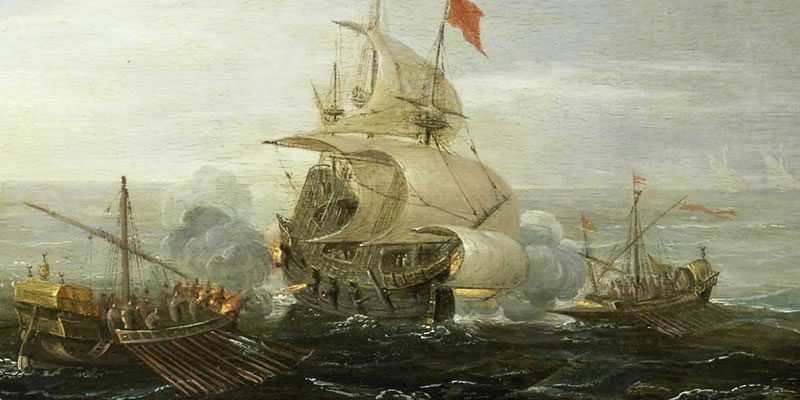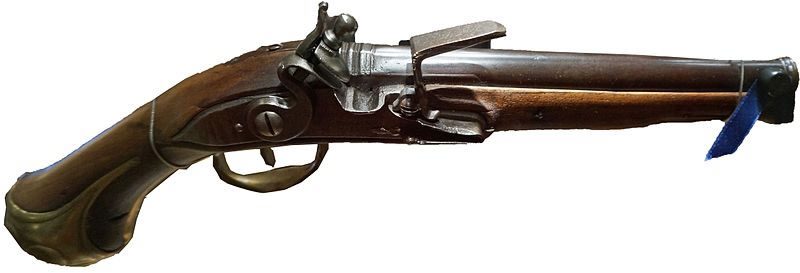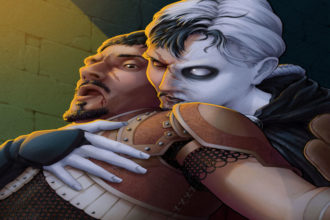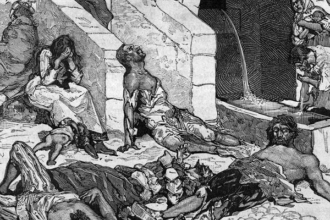World Building – Part 4: Making Your World Work

Intro | History | Religion | Working Worlds | Geography | Filling Your World | Your Players | Player Options
From Asgard to Zothique, there are many, many richly imagined worlds that have been created for books, games, movies, television and even just for fun. My favorite fantasy worlds feel like a real working place with their own currency, food, technology and magic. Last year, I decided it was finally time to tackle building my own fantasy world and in this article (Part 4), I share how I came up with details to make my seafaring world of Vodari feel more like a real place. Since this was my first crack at world building, I started small with just minor changes to the way a typical fantasy world works and added in a little gunpowder to allow for muskets and cannons.
Currency
When building out a campaign world, thinking about what people in the world call money can be a really nice detail. Currency has many names in fantasy and sci-fi settings such as Gil (Final Fantasy), Crowns, Units (Guardians of the Galaxy), Credits and more. Even if you settle on the old gold standard, nicknames for each coin can be a nice touch. Naming coins for the animal (real or monster) or person (king/queen of the land) they have minted onto a face is one way. Old names for coins can also be fun to use such as Groats, Sheckels, Farthings, Florins, Sovereigns, Guineas and Doubloons. For larger amounts, you might consider introducing bank notes, if some form of banking exists in your world. Whatever currency you choose, make sure it fits the setting and tone of your campaign and will actually work as an efficient method of exchange (complex math can be boring – really try to keep to a base 10 system).
The lack of money is the root of all evil.
~ Mark Twain
 When building out my campaign world, I really didn’t see the need to mess around with money too much. I just decided to drop Electrum coins (ep) as a standard of exchange and stick with Platinum, Gold, Silver and Copper. I also like to use bank notes for larger amounts, especially if the PCs are being paid for a job by a public official. In hindsight, I wish I came up with nicknames for my coins that sound more pirate-like such as Doubloons, but I was worried a name like that would pull us out of Vodari and into Earth’s actual history. I’m thinking that I am going to have my NPC pirates call gold coins Doubloons, Crowns or something with more flavor.
When building out my campaign world, I really didn’t see the need to mess around with money too much. I just decided to drop Electrum coins (ep) as a standard of exchange and stick with Platinum, Gold, Silver and Copper. I also like to use bank notes for larger amounts, especially if the PCs are being paid for a job by a public official. In hindsight, I wish I came up with nicknames for my coins that sound more pirate-like such as Doubloons, but I was worried a name like that would pull us out of Vodari and into Earth’s actual history. I’m thinking that I am going to have my NPC pirates call gold coins Doubloons, Crowns or something with more flavor.
A few things you can do to make the money of your world special:
- Unique Appearance: Make the appearance of the coins your players find be significant. Each empire can mint their own style, players can find coins from an evil empire of the past, etc. In Vodari, I thought about making the location of where the coins originate from be a bigger deal. I decided to leave that a detail for any specific treasures where that level of detail could matter for details such as who paid the dead mercenaries or who the pirates plundered to get their gold chests.
- Give Out Actual Coins (or replicas): My Vodari campaign is a virtual game on Roll20, but if we played in person it would be so fun to have little treasure chests full of fake coins. See 5 Fun Gimmicks for D&D for this idea and others.
- Bartering: Encounter a barter only culture for a session or two, but I would never recommend basing your game on something that crazy. If civilization breaks down in your world, you’ll need to demonstrate that currency is suddenly worth much less, since you can not eat it.
- Another Method of Exchange: Vodari has an island of ape people that use gems as an alternate method of exchange (well it did until my players arrived). In the Adventure Time homebrew rules players find US dollars or coins in dungeon treasure hoards. In the movie In Time, people trade the time they have left to live for everyday items like coffee.
Food
Otik’s Famous Spiced Potatoes (Dragonlance), blue milk (Star Wars), snakes and monkey brains (Indiana Jones and the Temple of Doom) or the replicator from Star Trek are all examples of food being used to make a world feel real. It’s easy to just have your players eat “food”, but it can be more. Describe the food and even create something unique and exotic that is only in your world. Make it part of the story like coconuts on Gilligan’s Island had coconuts or Breaking Bad’s Los Pollos chicken.
My players started out on in a small town, on a small island called Faraway. The island is famous for its stinky, barbed, rust colored fruit, called a Dragon Pear, that grows in orchards outside of the port town. When my players had to visit their first tavern I called it the Rusty Dragon, named for the fruit. Can you guess what the tavern’s signature dish is? It’s fried dragon pears and they taste awesome! Just a couple of details about a fruit and my world has some real details.
As my players travel around in my world…
- If a cart gets knocked over, maybe it is full of dragon pears.
- If the crowd throws rotten food, why not throw some stinky dragon pears.
- When my players travel to another town they might see some dragon pears at the market that cost three times more than the price just paid back on Faraway.
Your players can make food memorable too. Allow them to hunt and be specific about what they catch. If they kill a beast in a fight, why not eat it. When my players killed a giant crab, they cooked it and then ate it during a short rest. I think one of the players even had their PC carrying spices to make food on the road taste better.
Technology
The level of technology in your world, or even from land to land, is a dominate factor in the way the world works and how the campaign feels. Who has the best technology can also be a major story arc in your campaign. Which side has the death ray, atomic bomb, Death Star or whatever can be the entire focus of your PCs efforts. The level of technology and theme are both something your should really consult your players about. If your players are excited about playing in a world of sword and sorcery and you start introducing steam powered air ships and paddle boats, that is a major miss. But you need to be able to create a world that both you and your players can enjoy. If you are lucky, you’ll have players who can help you come up with a theme for your campaign that everyone can enjoy.
When I was starting to think about our next campaign, we were running a game set in the Nentir Vale and our group was looking to move away from goblins, kobolds, gnolls, orcs and red dragons. I looked at Guardians of the Galaxy, Maleficent, Hunger Games, Star Wars, Star Trek, Firefly, Van Helsing, Three Musketeers, Zelda, Pirates of the Caribbean, Aquaman, Legend of Korra and more for ideas. A few pages of notes later, I was able to present the following campaign ideas to my players:
- World of Islands
Epic medieval fantasy world where most land was covered by the sea long ago in a devasting war between two sister gods - Western
Desolate Western themed world with gunslingers and magic (see Wild Arms) - Gothic Horror
Ravenloft / Van Helsing / Hansel & Gretel theme where players are a group of monster hunters - Space
Magic is science in a galactic empire of planets under attack by “aliens” - Feywild
See Maleficent, Zelda & D&D Feywild
As a group we decided that letting me build out a world where a small continent was destroyed leaving scattered islands that the few survivors of this cataclysm colonized. Our swashbuckling adventures in the Seas of Vodari are set in a world with a technology level similar to that of the Renaissance. I started to develop a world with gunpowder (for cannons and muskets) and a little steam power being used by the rock gnomes in their far off island kingdom.
Once you set the level of technology for your world, you’ll need to provide that technology to your players. Since my world was basically a default D&D 5th edition world with gunpowder, I only had to create and borrow a dozen items to provide our unique mix of technology directly to my players. I also has to add boats and a combat system, which I am covering in my Naval Combat series.

Here is a list of what I created or borrowed from D&D/Pathfinder. Stats provided are for D&D 5th edition.
- Bayonet | 5 gp | 1 lb | Damage: 1d6 piercing | Properties: special
Special: It is a Use an Object action to attach a bayonet to or remove from a musket. Because bayonets are designed for use while attached to a musket. It counts as an improvised weapon that does 1d4 piercing damage (when used by itself). - Cutlass | 10 gp | 3 lbs | Damage: 1d8 slashing | Properties: Heavy blade
Proficiency: Melee martial weapons - Trident (Modified) | 5 gp | 4 lbs | Damage: 1d8 piercing | Properties: Versatile (1d10)
Proficiency: Melee martial weapons - Flintlock Pistol, Flintlock Musket, Bomb, Bullets, Gunpowder
See page 268 of the D&D 5e Dungeon Master’s Guide - Astrolabe | 100gp | 6 lbs
Complex astronomical device used at night to determine the date and time (which takes 1 minute). An astrolabe grants you a +2 bonus on Nature checks (related to geography) and Survival checks to navigate in the wilderness or at sea. - Eye Patch | 1 sp
An eye patch covers one eye and ties around the head and is worn to cover injured or blind eyes. Some wear eye patches to look more intimidating and some believe it helps to keep one eye covered when transitioning from the relative darkness belowdecks to the sunlight above. - Nautical Chart | 25 gp
Nautical charts map waterways, showing the depth of water and height (and shape) of coastlines, as well as currents, harbors, navigational hazards, reefs, and tides. If you are proficient with cartographer’s tools or have the Cartographer or Sailor background, a chart grants Advantage for Nature checks related to navigation when in the area detailed by the chart. - Hat | 1 sp to 5p gp | ½ lb to 2 lbs
Hats of various styles appear in all cultures. Ranging from the turban to the headscarf to the furred cap, a hat can be a simple covering for the head or a sign of rank and status. Particular hats are sometimes mandatory for social or religious sects. Pirates often wear bandanas or tricorn hats, while captains prefer bicornes and may wear them either “fore-and-aft” (with the points in front of and behind them) or “athwart” (sideways). - Reed Breathing Tube | 1 sp | 1/2 lb.
Allows wearer to breathe from 1-2 feet under the surface of the water in calm waters. If swimming in rough waters, the use of the device will be difficult or impossible. - Sextant | 500 gp | 2lbs
A sextant is used to determine your latitude, and grants you Advantage on Survival checks made to navigate while above ground during the day or night. You must be able to see the sun (day) or stars (night) to use this device. - Tar Bomb | 15 gp | 2 lbs
A tar bomb is an easy weapon to make, and devastating in use. A head-sized lump of tar is wrapped around a rope and set on fire. You use the rope to lob the burning tar onto an enemy’s deck, where it sticks and sets the ship alight. A hit with a tar bomb deals 1d4 points of fire damage and has the potential to set the struck object or creature on fire, causing an additional 1d6 points of fire damage each round unless the target or an adjacent creature makes a DC 15 Dexterity save to extinguish the flames as a full-round action. Knocking the tar bomb or the burning creature or object into a body of water or magically extinguishing the flames automatically smothers the fire. - Tattoo | 1 cp – 20gp (or free… ouch!)
The quality, size, and number of colors used are all a factor in the cost of a tattoo. Tattoos can be used to enhance character backgrounds and appearance.
Magic
As much as the technology level of your world can set the feel of the entire campaign and shape empires, magic can be used as an even more powerful force to wield. Magic can give people the power to heal and build or kill and destroy. Like technology, it can be a blessing or a curse. For my first world building exercise, I decided that leaving magic alone would be a really great idea. However you decide to use magic in your world, you’ll need to think about the following:
- How does magic work? What is the source of magical power for each type of magic user? Nature, arcane, divine?
In Vodari, I just went with the way things are set out in the rules for Dungeons & Dragons 5th edition. - How is magicical knowledge shared and controlled in your world?
In Vodari, some magically sensitive children are sent to Wizard school to become an apprentice. Clerics are given a gift for their devotion. Druids pass on their knowledge. Sorcerers and Warlocks find their own path. - How common is magic use in your world?
In Eberron, magic is used like a utility and in Thor’s Asgard magic and science are the same. In Vodari, the weather is dominated by a magical super hurricane that has been active for almost 1000 years. In my game world, magic users, like adventurers, are rare. Most people are happy to live out their lives on their small islands as farmers and merchants. Those who do travel pray to the gods for safe passage across the dangerous seas of Vodari.
Next week I’ll cover look at how to create a detailed geography for your world.
Each week I’ll add another part to this series. Here is a list of the published and upcoming parts.



